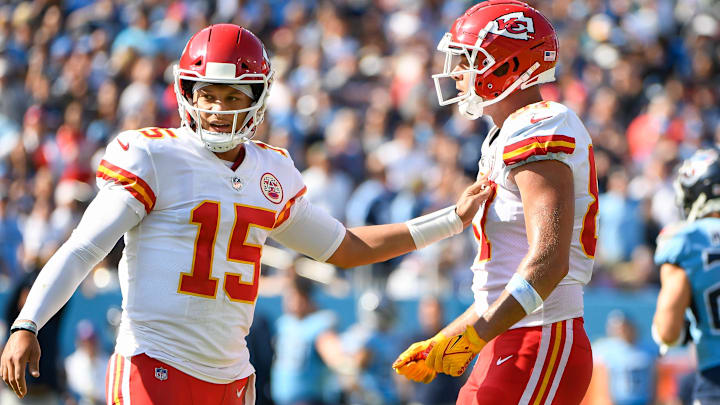When betting on a sporting event, there are a variety of wagers that a bettor can place on the game.
However, if you’re looking to pick the winner of a sporting event but aren’t sold on a team covering the point spread, then a moneyline bet is the perfect option for sports bettors.
Here is everything you need to know about moneyline bets:
Moneyline Bets Explained & Meaning
A moneyline bet is simply when you pick the winner of a given sporting event.
The odds for the moneyline will be adjusted based on each team or player’s ability, which means there is much more variability in terms of how much you can win or lose than compared to a point spread.
With a point spread, the spread is used to make the game “even” and it is usually accompanied by -110 American odds in football and basketball.
However, with a moneyline, since you are only picking the team to win the game without a point spread involved, the odds will vary based on the strength of the two teams, or players involved.
Let’s look at a quick example of a game from Week 18 of the 2021 NFL season:

Here, the Kansas City Chiefs face the Denver Broncos and are a much superior team. Kansas City is fighting for the top seed in its conference while the Broncos are going to miss the playoffs in the 2021 season.
Therefore, bettors would need to risk more money on the Chiefs in order to increase their payout.
Moneyline bets use American odds, which are centered around a bet of $100.
In this instance, the Chiefs are set at minus odds (-495), meaning you would need to risk $495 to win $100 if the Chiefs win the game. For the Broncos side, a $100 bet would win you $370 since they are at plus odds (+370).
How do Moneylines Work?
As mentioned above, all moneyline bets will be formatted in American odds like the example from WynnBET Sportsbook.
Betting on the Favorite: The team that is favored to win the game will have the minus (-) sign in front of its odds, meaning that you will need to risk that amount of money to win $100. However, you don’t need to only bet in intervals of $100. In the Chiefs example above, you would win $1 for every $4.95 risked on Kansas City.
Betting on the Underdog: The team that is the underdog in the game will have a plus sign (+) next to its odds. This means you will earn that amount for every $100 risked if the underdog wins the game. In the Broncos-Chiefs example, you would earn $3.70 for every $1 risked if the Broncos win.

Moneyline odds vary much more than the odds associated with a spread since the spread is designed to even the payout between the sides in a game.

In this game, the Chiefs are 10-point favorites, which means bettors will have to risk more for them to simply win the game since oddsmakers believe that giving Denver 10 points would make this a more even matchup.
By betting on the moneyline, any outcome of the game where the Chiefs win will allow a bettor who wagered in their -495 moneyline to cash. The same goes for bettors that wager on the Broncos at +370 odds if they win the game.
Moneyline bets completely take the spread out of the equation when picking the winner of a game.
Formula to Calculate Moneyline Odds
Here are two formulas that will allow you to easily calculate moneyline odds for favorites and underdogs.
Sportsbooks will make the calculations for you, but if you’re interested in seeing how much a bet would pay on your own, here's how:

Why/When Should I Bet on a Moneyline?
There are a few reasons why bettors should consider a moneyline bet.
In sports like baseball or hockey that are lower scoring, the moneyline is the most popular bet to make.
While the point spread is a more popular bet in football and basketball, there are few situations where betting on the moneyline is a good move as well.
- If you think an underdog will win a game straight up and not just cover the point spread, betting on the moneyline will lead to a bigger payout if the team does win.
- If you think a favorite will win the game, but not cover the spread.
Betting on the moneyline can also be applied to the futures market, for example every team has a moneyline that shows how likely they are to win the Super Bowl that season.

Explaining Juice on Moneylines
The cut that a sportsbook takes on each bet is called “juice,” and when betting on moneylines, the juice is the gap between the two moneylines.
For example, in our Broncos-Chiefs example, you have to risk more the favorite (Kansas City) than you would win by betting on the underdog (Denver).

Similar to the -110 odds on the point spread, sportsbooks juice moneylines in the same way.
In this example, the implied probability that the Chiefs win is 83.19 percent, while the implied probability that Denver wins is 21.28 percent.
Since that actually totals 104.47 percent, it means that the sportsbook has a 4.47% hold on this wager.
Check out BetSided for our favorite picks and plays each day, some of which will include moneyline bets on action in each of the major sports.
Learn more about sports betting in the US in our Sports Betting Education guide.
